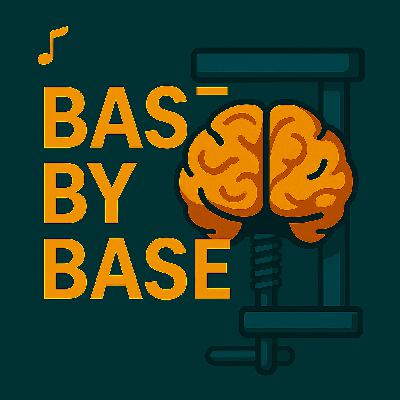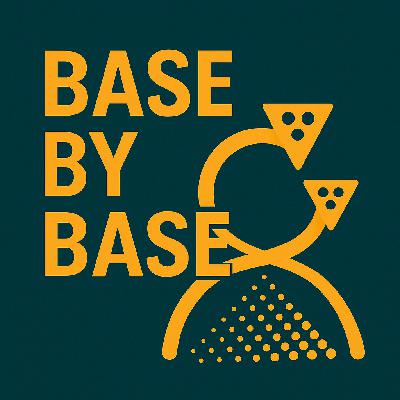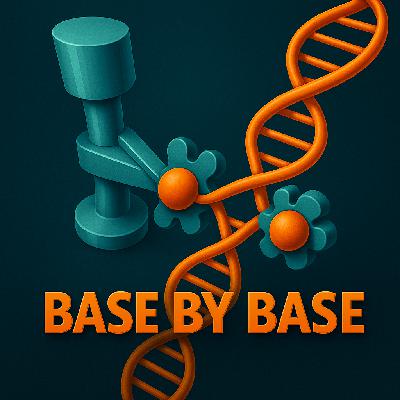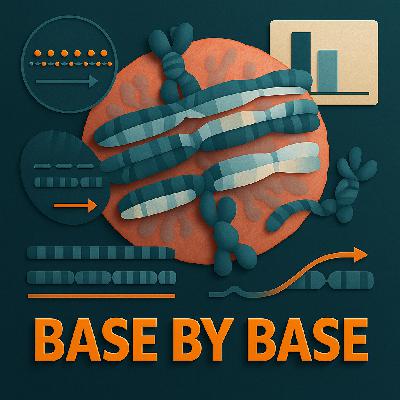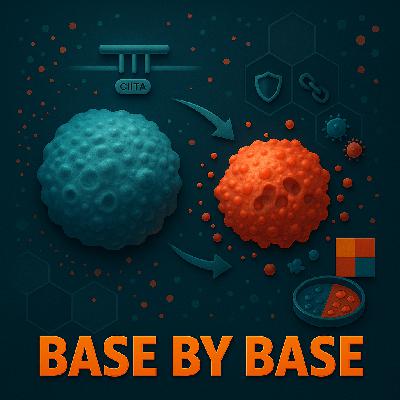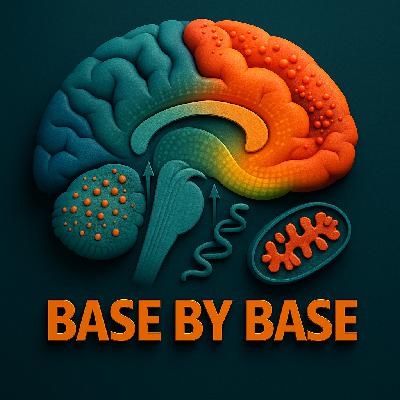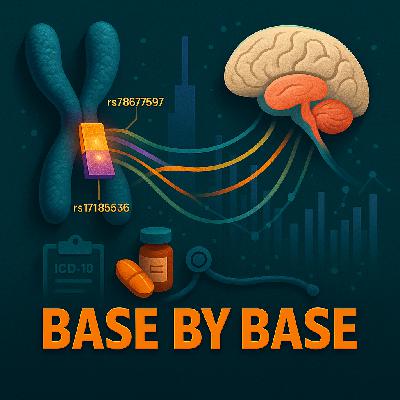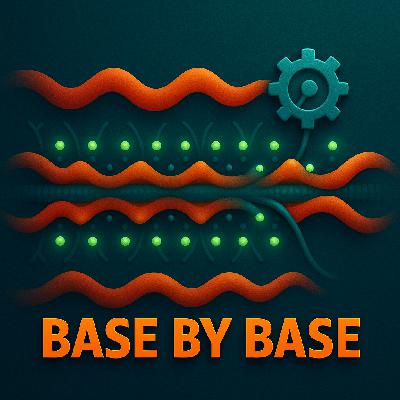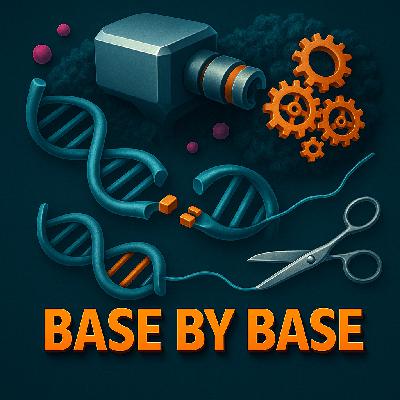Discover Base by Base
Base by Base

Base by Base
Author: Gustavo Barra
Subscribed: 6Played: 299Subscribe
Share
© Gustavo Barra
Description
Base by Base explores advances in genetics and genomics, with a focus on gene-disease associations, variant interpretation, protein structure, and insights from exome and genome sequencing. Each episode breaks down key studies and their clinical relevance—one base at a time.
Powered by AI, Base by Base offers a new way to learn on the go. Special thanks to authors who publish under CC BY 4.0, making open-access science faster to share and easier to explore.
Powered by AI, Base by Base offers a new way to learn on the go. Special thanks to authors who publish under CC BY 4.0, making open-access science faster to share and easier to explore.
223 Episodes
Reverse
️ Episode 198: Mechanical Confinement and the Shape-Shifting Life of Melanoma Cells
In this episode of PaperCast Base by Base, we explore how physical forces in the tumor microenvironment can push melanoma cells to switch from a pigment-producing, proliferative state into an invasive, drug-tolerant one, focusing on new work that links mechanical confinement, chromatin remodeling, and neuronal-like programs in cancer.
Study Highlights:Using a zebrafish model of BRAFV600E-driven melanoma together with human tumor samples and single-cell transcriptomics, the authors identify a subpopulation of tumor cells at the tumor–microenvironment interface that displays elongated nuclei and a gene expression program resembling undifferentiated, neuron-like cells. In vitro confinement of human melanoma cells under a polydimethylsiloxane piston recapitulates this interface state, triggering assembly of a perinuclear cage of acetylated microtubules that protects the nucleus from mechanical stress. Mechanical confinement selectively upregulates the chromatin-bending protein HMGB2, whose increased residence time on chromatin opens neuronal and invasive gene loci and engages pathways such as Notch and BRN2 that drive a switch toward an invasive phenotype. Genetic disruption of HMGB2 in zebrafish melanomas and human melanoma cells shifts the balance back toward proliferation with larger but less invasive tumors, whereas HMGB2 overexpression enhances invasion and tolerance to BRAF and MEK inhibition in mouse xenografts.
Conclusion:Mechanical confinement within the tumor microenvironment can rewire melanoma cells through HMGB2-dependent chromatin remodeling to favor an invasive, neuronal-like and drug-tolerant state over purely proliferative growth.
Music:Enjoy the music based on this article at the end of the episode.
Reference:Hunter MV, Joshi E, Bowker S, Montal E, Ma Y, Kim YH, Yang Z, Tuffery L, Li Z, Rosiek E, Browning A, Moncada R, Yanai I, Byrne H, Monetti M, de Stanchina E, Hamard P-J, Koche RP, White RM. Mechanical confinement governs phenotypic plasticity in melanoma. Nature. 2025;647:517–527. https://doi.org/10.1038/s41586-025-09445-6
License:This episode is based on an open-access article published under the Creative Commons Attribution 4.0 International License (CC BY 4.0) – https://creativecommons.org/licenses/by/4.0/
Support:Base by Base – Stripe donations: https://donate.stripe.com/7sY4gz71B2sN3RWac5gEg00
Official websiteBase by Base – https://basebybase.com/
On PaperCast Base by Base you’ll discover the latest in genomics, functional genomics, structural genomics, and proteomics.
️ Episode 163: Animal origins: looping back in time
In this episode of PaperCast Base by Base, we explore how chromatin folding mechanisms emerged alongside animal evolution, focusing on a Spotlight article that synthesizes high-resolution 3D genome maps across unicellular relatives of animals and early-branching metazoans to probe when enhancer–promoter looping first appeared.
Study Highlights:This Spotlight reviews evidence from micro-C datasets spanning ichthyosporeans, filastereans, choanoflagellates, sponges, ctenophores, placozoans, and cnidarians, showing that broad A/B-like chromatin compartments and, crucially, enhancer–promoter chromatin loops are features that arise within animals rather than in their unicellular relatives. It emphasizes that loops are readily detected in early metazoans such as ctenophores, placozoans, and cnidarians, while sponges show weaker or absent looping signals, hinting at lineage-specific trajectories or possible secondary loss. The article highlights unusual promoter hubs in placozoans, where hundreds of transcription start sites cluster, potentially coordinating housekeeping expression programs. Mechanistically, ctenophores appear to use abundant C2H2 zinc-finger proteins that bind unmethylated motifs at loop anchors, suggesting alternative loop-formation strategies distinct from the CTCF-driven loop extrusion and insulated TAD architecture characterized in vertebrates. Together, these observations argue that chromatin loops emerged with complex gene regulation in animals and diversified across lineages instead of following a single universal mechanism.
Conclusion:Chromatin looping likely originated at the dawn of animal life and diversified across lineages, underpinning the rise of complex gene regulation before the canonical, CTCF-insulated TAD architecture seen in many bilaterians.
Reference:Matar, O., & Marlétaz, F. (2025). Animal origins: looping back in time. Trends in Genetics. https://doi.org/10.1016/j.tig.2025.06.013
License:This episode is based on an open-access article published under the Creative Commons Attribution 4.0 International License (CC BY 4.0) – https://creativecommons.org/licenses/by/4.0/
Support:If you'd like to support Base by Base, you can make a one-time or monthly donation here: https://basebybase.castos.com/
Episode Slug: animal-origins-looping-back-in-time
Keywords: chromatin loops; animal evolution; Micro-C; ctenophores; enhancer–promoter interactions
️ Episode 223: Torsion Regulates DNA Replication Stalling and Restart
In this episode of PaperCast Base by Base, we explore New single-molecule angular optical trap assays reveal that DNA torsion directly controls T7 replisome stalling and reactivation
Study Highlights:A high-resolution, label-free angular optical trap (AOT) assay was developed to track T7 replisome-driven DNA rotation and torsional slowing in real time. The combined helicase–DNA polymerase (DNAP) replisome generates ∼22 pN·nm of stall torque, about twice that of E. coli RNA polymerase, while helicase or DNAP alone produce minimal positive torque. Loss of the helicase C‑terminal domain interaction with DNAP increases fork regression under torsion and reduces restart efficiency, and prolonged stalling leads to replisome inactivation. Excess free DNAP at the fork and gyrase-mediated torsional relaxation substantially improve restart after a torsion-induced stall
Conclusion:Torsional stress is a central regulator of fork stability and restart, with helicase–DNAP synergy and timely topoisomerase activity determining whether stalled replisomes reactivate
Music:Enjoy the music based on this article at the end of the episode.
Reference:Xiaomeng Jia, Xiang Gao, Shuming Zhang, James T. Inman, Yifeng Hong, Anupam Singh, Fahad Rashid, James M. Berger, Smita S. Patel & Michelle D. Wang. Torsion is a dynamic regulator of DNA replication stalling and reactivation. Nat Commun. 2025;16:10543. https://doi.org/10.1038/s41467-025-65567-5
License:This episode is based on an open-access article published under the Creative Commons Attribution 4.0 International License (CC BY 4.0) – https://creativecommons.org/licenses/by/4.0/
Support:Base by Base – Stripe donations: https://donate.stripe.com/7sY4gz71B2sN3RWac5gEg00
Official website https://basebybase.com
Castos player https://basebybase.castos.com
On PaperCast Base by Base you’ll discover the latest in genomics, functional genomics, structural genomics, and proteomics.
Keywords: DNA replication, torsion, replisome, helicase, DNA polymerase
️ Episode 222: snaR-A hijacks splicing to drive proliferation
In this episode of PaperCast Base by Base, we explore This episode examines how the cancer-associated Pol III transcript snaR-A binds core splicing factors, localizes near nuclear speckles, perturbs U2-dependent splicing to increase intron retention, and promotes cell proliferation linked to poorer patient outcomes
Study Highlights:Proteomic pull-downs and CLIP analyses reveal snaR-A interactions with RNA chaperones (La, ILF3) and multiple splicing factors, with PAR-CLIP and CLIP-qPCR supporting a direct interaction with the U2 snRNP subunit SF3B2. HCR-RNA-FISH and SON TSA-seq place snaR-A in subnuclear foci adjacent to nuclear speckles and show snaR-A gene clusters are speckle-proximal. Functional genomics show snaR-A overexpression increases intron retention while snaR-A depletion reduces intron retention and enhances splicing of transcripts marked by high U2 occupancy and speckle proximity, and snaR-A overexpression selectively reduces SF3B2 protein levels. Phenotypically, snaR-A depletion lowers proliferation in HEK293T cells, snaR-A gene activity correlates with proliferation markers across primary tumors and predicts worse survival, and rescued splicing increases protein abundance for tumor-suppressive targets such as OGFR.
Conclusion:snaR-A acts as a nuclear antagonist of U2-dependent splicing near speckles, promoting cell proliferation and providing a non-mutational route to splicing dysregulation in cancer
Music:Enjoy the music based on this article at the end of the episode.
Reference:Zhou S, Lizarazo S, Chorghade S, Mouli L, Cheng R, KC R, Kalsotra A, Van Bortle K. Cancer-associated snaR-A noncoding RNA interacts with core splicing machinery and disrupts processing of mRNA subpopulations. Nat Commun. 2025;16:10460. https://doi.org/10.1038/s41467-025-65448-x
License:This episode is based on an open-access article published under the Creative Commons Attribution 4.0 International License (CC BY 4.0) – https://creativecommons.org/licenses/by/4.0/
Support:Base by Base – Stripe donations: https://donate.stripe.com/7sY4gz71B2sN3RWac5gEg00
Official website https://basebybase.com
Castos player https://basebybase.castos.com
On PaperCast Base by Base you’ll discover the latest in genomics, functional genomics, structural genomics, and proteomics.
Keywords: snaR-A, splicing, SF3B2, intron retention, nuclear speckles
️ Episode 221: Allele-resolved nanopore tour of the human placental methylome
In this episode of PaperCast Base by Base, we explore Using phased long-read nanopore and short-read sequencing across eight trios, the study maps allele-specific DNA methylation and transcription in female human placentas, identifies hundreds of DMRs and novel imprinted genes, and reports somatic placental variants
Study Highlights:The authors combined >20x Oxford Nanopore whole-genome sequencing with Illumina WGS and RNA-seq in eight mother–father–placenta trios to phase reads into maternal and paternal alleles. They catalogued 723 differentially methylated regions, finding a strong bias toward paternal demethylation concentrated in partially methylated domains. Allele-resolved expression analysis identified 74 imprinted genes and revealed previously unreported imprinted loci including paternally expressed ILDR2 and maternally expressed RASA1. The study also detected widespread somatic point mutations and a small number of placenta-specific structural variants, including a CNDP1–ZNF407 duplication associated with altered gene expression
Conclusion:Phased nanopore sequencing provides a high-resolution, allele-specific map of the placental methylome and transcriptome, revealing novel imprinted genes and somatic variation with potential relevance to placental biology
Music:Enjoy the music based on this article at the end of the episode.
Reference:Kindlova M, Byrne H, Kubler JM, Steane SE, Whyte JM, Borg D, Clifton VL & Ewing AD. An allele-resolved nanopore-guided tour of the human placental methylome. Nat Commun. 2025;16:10358. https://doi.org/10.1038/s41467-025-65337-3
License:This episode is based on an open-access article published under the Creative Commons Attribution 4.0 International License (CC BY 4.0) – https://creativecommons.org/licenses/by/4.0/
Support:Base by Base – Stripe donations: https://donate.stripe.com/7sY4gz71B2sN3RWac5gEg00
Official website https://basebybase.com
Castos player https://basebybase.castos.com
On PaperCast Base by Base you’ll discover the latest in genomics, functional genomics, structural genomics, and proteomics.
️Episode 220: The AML cellular state space reveals NPM1 immune evasion subtypes
In this episode of PaperCast Base by Base, we explore Single-cell and bulk sequencing of 120 AML cases reveal two NPM1-mutated subtypes with distinct immune evasion mechanisms and divergent responses to hematopoietic stem cell transplantation
Study Highlights:Bulk RNA-seq profiles are strongly confounded by variable mature cell-type signatures that can conceal subtype-specific blast programs. Single-cell multimodal sequencing of AML identified four main clusters of immature leukemic cells and separated NPM1-mutated cases into NPM1class I and NPM1class II. NPM1class I is marked by MHC class II downregulation and shows a significant survival benefit from HSCT, while NPM1class II resists allogeneic T cell killing ex vivo and does not benefit from HSCT. A 180-gene signature, and a shorter 30-gene panel, distinguished the classes across external bulk cohorts and associated each subtype with different co-mutation patterns.
Conclusion:Single-cell transcriptional profiling defines two clinically relevant NPM1 subtypes with distinct immune evasion strategies that may inform HSCT decisions and immunotherapy approaches.
Music:Enjoy the music based on this article at the end of the episode.
Reference:Lilljebjörn H, Henningsson R, Rissler M, Landberg N, Puente-Moncada N, von Palffy S, Rissler V, Stanek P, Desponds J, Lazarevic V, Lehmann S, Fontes M, Ågerstam H, Sandén C, Orsmark-Pietras C, Zhong X, Juliusson G, Thorsson H, Fioretos T. The AML cellular state space unveils NPM1 immune evasion subtypes with distinct clinical outcomes. Nat Commun. 2025;16:10592. https://doi.org/10.1038/s41467-025-66546-6
License:This episode is based on an open-access article published under the Creative Commons Attribution 4.0 International License (CC BY 4.0) – https://creativecommons.org/licenses/by/4.0/
Support:Base by Base – Stripe donations: https://donate.stripe.com/7sY4gz71B2sN3RWac5gEg00
Official website https://basebybase.com
Castos player https://basebybase.castos.com
On PaperCast Base by Base you’ll discover the latest in genomics, functional genomics, structural genomics, and proteomics.
️Episode 219: Multi-omic mapping of lipid dysregulation in Parkinson’s brain
In this episode of PaperCast Base by Base, we explore Targeted multi-region lipidomics with proteomic and mitochondrial data reveals region- and stage-specific lipid alterations in Parkinson’s disease that converge on mitochondrial dysfunction
Study Highlights: The study quantified 146 lipid species across eight anatomically distinct post-mortem brain regions in controls and mid- and late-stage Parkinson’s disease using targeted LC-MS/MS and integrated proteomics and mitochondrial assays. Control brains showed distinct regional lipid signatures and age-associated increases in hexosylceramides, while PD brains exhibited cortical elevations of gangliosides, HexCer and Hex2Cer and subcortical reductions of glycosphingolipids alongside increased sphingolipids and decreased phospholipids. The putamen displayed the most pronounced mid-stage changes with depletion of very long-chain ceramides and plasmalogen PE that normalized in late-stage disease, and lyso-phosphatidylcholine rose progressively with disease stage. Correlative multi-omic analysis linked sphingomyelin species to PD-related proteins and associated putaminal lipids including plasmalogens, long-chain ceramides, lyso-PC and HexCer with altered mitochondrial complex I activity.
Conclusion: Region- and stage-specific lipid remodeling in Parkinson’s disease converges with mitochondrial dysfunction and identifies lipid pathways that may contribute to disease progression and therapeutic targeting
Music: Enjoy the music based on this article at the end of the episode.
Reference: Hällqvist J, Toomey CE, Pinto R, Baldwin T, Doykov I, Wernick A, Al Shahrani M, Evans JR, Lachica J, Pope S, Heales S, Eaton S, Mills K, Gandhi S & Heywood WE. Multi-omic analysis reveals lipid dysregulation associated with mitochondrial dysfunction in Parkinson’s disease brain. Nature Communications. 2025;16:10490. https://doi.org/10.1038/s41467-025-65489-2
License: This episode is based on an open-access article published under the Creative Commons Attribution 4.0 International License (CC BY 4.0) – https://creativecommons.org/licenses/by/4.0/
Support: Base by Base – Stripe donations: https://donate.stripe.com/7sY4gz71B2sN3RWac5gEg00
Official website https://basebybase.com
Castos player https://basebybase.castos.com
On PaperCast Base by Base you’ll discover the latest in genomics, functional genomics, structural genomics, and proteomics.
️Episode 218: SIM1 and the multi-ancestry genomics of erectile dysfunction
In this episode of PaperCast Base by Base, we explore A large multi-ancestry GWAS meta-analysis identifies a dominant SIM1-linked locus and multiple genetic connections between electronic health record-defined erectile dysfunction and cardiometabolic, psychiatric, and substance-use traits
Study Highlights: Meta-analysis of 913,194 European and 125,315 African ancestry individuals (136,867 and 51,599 cases respectively) identified 40 independent variants in Europeans, two in Africans, and 51 lead SNPs in cross-ancestry analyses.
The strongest associations mapped to a non-coding region regulating SIM1, led by rs78677597 in Europeans and rs17185536 in Africans and in the cross-ancestry meta-analysis. Genetic correlations and local analyses linked EHR-defined ED with psychiatric disorders, cardiometabolic traits, and substance use traits, and Mendelian randomization inferred bidirectional and directional causal relationships involving obesity, type 2 diabetes, cannabis use disorder and opioid use disorder.
Polygenic risk scores explained up to 9.2% of variance but showed limited predictive power (AUC = 0.52), while gene-based and TWAS analyses highlighted ESR1, CTNNB1 and SLC39A8 and drug-repurposing nominated ER-α antagonists and sulindac as candidates. Conclusion: The study confirms a dominant SIM1-associated genetic signal for erectile dysfunction and reveals a complex, multi-factorial genetic architecture linking ED to cardiometabolic, psychiatric, and substance-use biology
Music: Enjoy the music based on this article at the end of the episode.
Reference: Bright U, Chen Y, Deak JD, Zhou H, Levey DF, Gelernter J. Multi-ancestry investigation of the genomics of erectile dysfunction. Nat Commun. 2025. https://doi.org/10.1038/s41467-025-66723-7
License: This episode is based on an open-access article published under the Creative Commons Attribution 4.0 International License (CC BY 4.0) – https://creativecommons.org/licenses/by/4.0/
Support: Base by Base – Stripe donations: https://donate.stripe.com/7sY4gz71B2sN3RWac5gEg00
Official website https://basebybase.com
Castos player https://basebybase.castos.com
On PaperCast Base by Base you’ll discover the latest in genomics, functional genomics, structural genomics, and proteomics.
️Episode 217: Multiscale triads of meiotic crossover patterning
In this episode of PaperCast Base by Base, we explore FFT and inverse-FFT analysis of Zip3/Zip2, Hop1 and Zip1 on yeast pachytene chromosomes reveals two interdigitated tiers of evenly spaced protein triads that correspond to canonical and minority crossovers and are differentially regulated by Pch2/TRIP13 Study
Highlights: Quantitative fluorescence profiles and Fourier analysis identify two dominant spatial periodicities centered near 0.5 µm and 1.0 µm for Zip3/Zip2, Hop1 and Zip1 along pachytene chromosomes. Inverse FFT reconstructs narrow and broad peaks that colocalize into triads of the three proteins with intra-triad separations of ~70 nm.
Shorter-periodicity triads map to canonical Zip3-defined crossovers and show classical interference, while longer-periodicity triads are interdigitated with shorter triads and also exhibit interference. The ratio, spacing relationships, and modulation by Pch2/TRIP13 support the interpretation that longer-periodicity triads correspond to minority crossovers and that Pch2 selectively alters abundance and relative loading in the longer-tier triads
Conclusion: Crossover interference establishes two interdigitated, multiscale patterns of tightly clustered Zip2/Zip3–Hop1–Zip1 triads along meiotic chromosomes, linking canonical and minority crossovers into a single interference-governed process
Music: Enjoy the music based on this article at the end of the episode.
Reference: White MA, Weiner B, Chu L, Lim G, Prentiss M & Kleckner N. Crossover interference mediates multiscale patterning along meiotic chromosomes. Nature Communications. 2025;16:10453. https://doi.org/10.1038/s41467-025-65423-6
License: This episode is based on an open-access article published under the Creative Commons Attribution 4.0 International License (CC BY 4.0) – https://creativecommons.org/licenses/by/4.0/
Support: Base by Base – Stripe donations: https://donate.stripe.com/7sY4gz71B2sN3RWac5gEg00
Official website https://basebybase.com
Castos player https://basebybase.castos.com
On PaperCast Base by Base you’ll discover the latest in genomics, functional genomics, structural genomics, and proteomics.
️ Episode 216: 53BP1-RIF1 and DNA-PKcs: distinct interactions in chromosomal break repair
In this episode of PaperCast Base by Base, we explore This episode reviews a study showing that 53BP1-RIF1 and DNA-PKcs have different genetic relationships across blunt end joining, deletion patterns, HDR, and radiosensitivity
Study Highlights:Using EJ7-GFP and MA-del reporters in HEK293 cells, loss of 53BP1 alone did not reduce blunt No Indel EJ but amplified the decrease caused by DNA-PKcs kinase inhibition (M3814) or PRKDC knockout. Disruption of 53BP1 or RIF1, and DNA-PKcs inhibition or loss, each caused a similar shift toward deletions with increased microhomology and reduced non-microhomology deletions, with combined disruption not additive. 53BP1 loss reduced blunt EJ efficiency in XLF-deficient cells and the deletion pattern of the 53BP1/XLF double mutant resembled that of 53BP1 loss alone. DNA-PKcs kinase inhibition produced marked increases in HDR and radiosensitivity that differed from genetic DNA-PKcs loss and were not fully additive with 53BP1 or RIF1 loss.
Conclusion:53BP1-RIF1 act as a backup to DNA-PKcs for blunt DSB end joining but function in the same pathway as DNA-PKcs to limit microhomology-mediated deletions, while DNA-PKcs kinase inhibition broadly perturbs repair outcomes and increases radiosensitivity
Music:Enjoy the music based on this article at the end of the episode.
Reference:Makins K, Cisneros-Aguirre M, Lopezcolorado FW & Stark JM. 53BP1-RIF1 and DNA-PKcs show distinct genetic interactions with diverse chromosomal break repair outcomes. Nature Communications. 2025;16:10361. https://doi.org/10.1038/s41467-025-65329-3
License:This episode is based on an open-access article published under the Creative Commons Attribution 4.0 International License (CC BY 4.0) – https://creativecommons.org/licenses/by/4.0/
Support:Base by Base – Stripe donations: https://donate.stripe.com/7sY4gz71B2sN3RWac5gEg00
Official website https://basebybase.com
Castos player https://basebybase.castos.com
On PaperCast Base by Base you’ll discover the latest in genomics, functional genomics, structural genomics, and proteomics.
️ Episode 215: Protein Set Transformer for high-diversity viromics
In this episode of PaperCast Base by Base, we explore Protein Set Transformer (PST) is a protein-based genome language model that represents genomes as sets of proteins to improve genome and protein representations across diverse viral datasets
Study Highlights:PST embeds proteins with ESM2, concatenates positional and strand vectors, contextualizes proteins with a multi-head attention encoder, and produces genome embeddings via a learnable weighted decoder pooling. The foundation PST-TL models were pretrained on >100k dereplicated viral genomes encoding >6M proteins using a triplet-loss objective with PointSwap augmentation and evaluated on IMG/VR v4 and MGnify soil virus test sets. PST-TL outperformed other protein- and nucleotide-based methods at recovering genome–genome relationships, including remote relationships, and its protein embeddings clustered structural capsid folds and late-gene functional modules. PST improved annotation transfer for hypothetical proteins via embedding and structure-aware clustering and boosted viral host-species prediction when used in a graph link-prediction framework.
Conclusion:PST provides transferable genome- and protein-level embeddings that strengthen representation, annotation, and host-prediction tasks for diverse viral and microbial genomics applications
Music:Enjoy the music based on this article at the end of the episode.
Reference:Martin, C., Gitter, A., Anantharaman, K. Protein Set Transformer: a protein-based genome language model to power high-diversity viromics. Nat Commun (2025). https://doi.org/10.1038/s41467-025-66049-4
License:This episode is based on an open-access article published under the Creative Commons Attribution 4.0 International License (CC BY 4.0) – https://creativecommons.org/licenses/by/4.0/
Support:Base by Base – Stripe donations: https://donate.stripe.com/7sY4gz71B2sN3RWac5gEg00
Official website https://basebybase.com
Castos player https://basebybase.castos.com
On PaperCast Base by Base you’ll discover the latest in genomics, functional genomics, structural genomics, and proteomics.
Episode link: https://basebybase.castos.com/episodes/protein-set-transformer
Chapters
(00:00:00) - Deep Learning in Viral Biology(00:02:31) - Preliminary insights into viral biology(00:08:01) - PSTTL: The Hidden Genome of Viruses(00:11:29) - PSTTL: The Virality Model(00:14:22) - Preston 2, Context-aware viral evolution(00:16:19) - Signs and Numbers in the Code
️ Episode 214: PI(4,5)P2 Asymmetry Enables Rapid FGF2 Secretion
In this episode of PaperCast Base by Base, we explore This study shows that an asymmetric transbilayer distribution of PI(4,5)P2 lowers the energy barrier for lipidic pore formation and accelerates unconventional secretion of Fibroblast Growth Factor 2
Study Highlights:The authors generated asymmetric LUVs and GUVs by enzymatically converting outer-leaflet PI(4)P to PI(4,5)P2 using PIP5K1C and validated PI(4,5)P2 presence with FGF2-GFP and FGF2-Halo binding assays. GUV reconstitution assays revealed that outer-leaflet enrichment of PI(4,5)P2 shortened mean FGF2-dependent pore formation times from ~95 minutes to ~45 minutes without changing final pore frequency. In CHO-K1 cells, delivery of exogenous PI(4,5)P2 to the outer leaflet disrupted transbilayer asymmetry and acutely inhibited FGF2 secretion, an effect mirrored by PI(3,4)P2 and PI(3,4,5)P3 but not by PI(4)P or phosphatidylserine. Exogenously added PI(4,5)P2 was cleared from the cell surface within 40–60 minutes and FGF2 secretion recovered, supporting a reversible, asymmetry-dependent mechanism
Conclusion:Transbilayer asymmetry of PI(4,5)P2 is a key biophysical determinant that lowers the energetic cost of membrane pore opening and is required for fast unconventional secretion of FGF2
Music:Enjoy the music based on this article at the end of the episode.
Reference:Kaur, M., Lolicato, F., Nickel, W. Plasma membrane transbilayer asymmetry of PI(4,5)P2 drives unconventional secretion of Fibroblast Growth Factor 2. Nat Commun (2025). https://doi.org/10.1038/s41467-025-66860-z
License:This episode is based on an open-access article published under the Creative Commons Attribution 4.0 International License (CC BY 4.0) – https://creativecommons.org/licenses/by/4.0/
Support:Base by Base – Stripe donations: https://donate.stripe.com/7sY4gz71B2sN3RWac5gEg00
Official website https://basebybase.com
Castos player https://basebybase.castos.com
On PaperCast Base by Base you’ll discover the latest in genomics, functional genomics, structural genomics, and proteomics.
Episode link: https://basebybase.castos.com/episodes/pi45p2-transbilayer-asymmetry
Chapters
(00:00:00) - Deep Dive: The physics of cell secretions(00:02:46) - How FGF2 secreates from the cell(00:07:02) - Immunity 7, Asymmetry blocks FGF2 secretion(00:10:24) - What is it about PI4.5p that lowers the energy(00:13:39) - How to Find Your Way Through the Night
️ Episode 213: BRAIN-MAGNET: a functional atlas for non-coding variants
In this episode of PaperCast Base by Base, we explore BRAIN-MAGNET couples a ChIP-STARR-seq atlas of 148,198 neural regulatory elements with a validated convolutional neural network to predict enhancer activity and prioritize disease-relevant non-coding variants
Study Highlights:The authors generated an activity-ranked functional genomics atlas of 148,198 non-coding regulatory elements in human neural stem cells. Comparative ChIP-STARR-seq revealed many elements are epigenetically primed in embryonic stem cells for later neural activity. BRAIN-MAGNET, a convolutional neural network trained on the atlas, predicts enhancer activity from DNA sequence and computes nucleotide-level contribution scores to identify functional motifs. The model outperformed other prioritization scores at tested loci and enabled prioritization and functional validation of both common GWAS SNPs and rare variants, including a putative RAB7A enhanceropathy.
Conclusion:The NCRE atlas and BRAIN-MAGNET provide a functionally validated resource to interpret non-coding genetic variation relevant to neurodevelopment and neurological disease
Music:Enjoy the music based on this article at the end of the episode.
Reference:Deng R, Perenthaler E, Nikoncuk A, Yousefi S, Lanko K, Schot R, Maresca M, Medico-Salsench E, Sanderson LE, Parker MJ, van Ijcken WFJ, Park J, Sturm M, Haack TB, Roshchupkin GV, Mulugeta E, Barakat TS. BRAIN-MAGNET: A functional genomics atlas for interpretation of non-coding variants. Cell. 2026 Jan 22;189:1–20. https://doi.org/10.1016/j.cell.2025.10.029
License:This episode is based on an open-access article published under the Creative Commons Attribution 4.0 International License (CC BY 4.0) – https://creativecommons.org/licenses/by/4.0/
Support:Base by Base – Stripe donations:
Chapters
(00:00:00) - Finding the missing DNA in the brain(00:05:24) - Brain Magnet: The regulatory map of the brain(00:07:40) - Brain Magnet: The functional atlas(00:10:46) - Brain Magnet for SNPs and the neuropsychiatric disorders(00:12:06) - Brain Magnet for rare neurogenetic disorders(00:16:42) - Neuroscience: Hidden Codes in the Silent Frame
️ Episode 212: Zonal control of mutant β-catenin tumorigenesis
This study shows that hepatic zonation determines whether mutant β-catenin drives proliferation and liver cancer by forcing differentiation to a non-permissive zone 3 fate or, when reversed, enabling MAPK- and mTOR-dependent growth
Study Highlights:β-catenin exon 3 mutations cooperate with exogenous MYC to produce a proliferative translatome that supports tumour outgrowth. Differentiation to an extreme zone 3 GLUL+Lgr5+ hepatocyte fate suppresses the pro-growth translatome and is refractory to WNT/MYC-driven tumorigenesis. Early proliferative lesions that progress show reduced WNT activation, elevated MAPK signalling and engagement of an IGFBP2–mTOR–cyclin D1 axis, and inhibition of IGFBP2, mTOR or Yap/Taz impairs lesion formation and tumorigenesis. High-level WNT activation from Apc loss is less compatible with tumour formation, whereas MAPK activation (BrafV600E) antagonizes zone 3 differentiation to permit Lgr5+ hepatocyte transformation that can be suppressed by PORCN or BRAF inhibitors
Conclusion:Hepatocyte zonal identity dictates susceptibility to WNT-driven HCC, and escape from WNT-induced zone 3 differentiation plus activation of MAPK/mTOR pro-growth pathways is required for tumour initiation
Music:Enjoy the music based on this article at the end of the episode.
Reference:Raven A. et al. Hepatic zonation determines tumorigenic potential of mutant β-catenin. Nature. 2025. https://doi.org/10.1038/s41586-025-09733-1
License:This episode is based on an open-access article published under the Creative Commons Attribution 4.0 International License (CC BY 4.0) – https://creativecommons.org/licenses/by/4.0/
Support:Base by Base – Stripe donations: https://donate.stripe.com/7sY4gz71B2sN3RWac5gEg00
Official website https://basebybase.com
Castos player https://basebybase.castos.com
On PaperCast Base by Base you’ll discover the latest in genomics, functional genomics, structural genomics, and proteomics.
Chapters
(00:00:00) - Base by Bass(00:02:20) - Hepatic zonation 6, The liver paradox(00:03:35) - How does wnt signaling cause cancer?(00:06:28) - WNT mutations in the liver
️ Episode 211: Retention Elements in Cancer Cells
In this episode of PaperCast Base by Base, we explore the discovery of genetic elements that promote the retention of extrachromosomal DNA (ecDNA) in cancer cells, enhancing their survival and evolution.
Study Highlights:Researchers identified a family of genomic elements known as retention elements that tether ecDNA to mitotic chromosomes, facilitating its transmission to daughter cells during division. The study utilized a novel genome-scale assay called Retain-seq, revealing thousands of retention elements that enhance the persistence of ecDNA. These elements are primarily located at gene promoters and are characterized by high CpG density, which is crucial for their function. The findings suggest that retention elements play a significant role in the maintenance of oncogenic ecDNA across generations of cancer cells.
Conclusion:Understanding the mechanisms of ecDNA retention may provide insights into cancer evolution and potential therapeutic targets.
Music:Enjoy the music based on this article at the end of the episode.
Reference:Sankar, V., Hung, K. L., Gnanasekar, A., Wong, I. T.-L., Shi, Q., Kraft, K., Jones, M. G., He, B. J., Yan, X., Belk, J. A., Liu, K. J., Agarwal, S., Wang, S. K., Henssen, A. G., Mischel, P. S., & Chang, H. Y. (2025). Genetic elements promote retention of extrachromosomal DNA in cancer cells. Nature. https://doi.org/10.1038/s41586-025-09764-8
License:This episode is based on an open-access article published under the Creative Commons Attribution 4.0 International License (CC BY 4.0) – https://creativecommons.org/licenses/by/4.0/
Support:Base by Base – Stripe donations: https://donate.stripe.com/7sY4gz71B2sN3RWac5gEg00
Official website https://basebybase.com
Castos player https://basebybase.castos.com
On PaperCast Base by Base you’ll discover the latest in genomics, functional genomics, structural genomics, and proteomics.
Chapters
(00:00:00) - How does rogue DNA stay in cancer cells?(00:02:36) - Cancer DNA: The retention mechanism(00:07:29) - Cancer epigenetic retention elements(00:12:47) - Circles that refuse to fall: the cancer drug strategy
️ Episode 210: Tumour-Reactive CD8 T Cell Clusters in Human Melanoma In this episode of PaperCast Base by Base, we explore how tumour-reactive CD8 T cells organize into stable clusters with melanoma cells and antigen-presenting cells, and how these structures can be isolated from patient samples to boost anti-tumour immunity.
Study Highlights:The authors used conventional and imaging flow cytometry to identify heterotypic clusters in which CD8 T cells were physically conjugated to tumour cells and antigen-presenting cells across 21 human melanoma metastases. Single-cell RNA and TCR sequencing showed that clustered CD8 T cells were more clonally expanded and displayed gene expression signatures of tumour reactivity, activation and exhaustion, whereas single CD8 T cells were enriched for naive and bystander-like states. Specific melanoma and myeloid subpopulations with strong antigen-presentation, interferon signalling and chemokine expression were preferentially engaged in these clusters, highlighting non-random, ligand–receptor-driven interactions in the tumour microenvironment. When expanded ex vivo, T cells derived from clusters produced more cytokines and showed markedly higher cytotoxicity against autologous melanoma cells than T cells from singlets. In mouse models bearing patient-derived melanomas, adoptive transfer of cluster-derived T cells led to stronger T cell infiltration, activation and tumour control than transfer of T cells expanded from single-cell gates.
Conclusion:Heterotypic CD8 T cell clusters represent a powerful and previously overlooked source of tumour-reactive T cells and TCRs that could be harnessed to refine and enhance adoptive T cell therapies, including TIL-based treatment strategies.
Music:Enjoy the music based on this article at the end of the episode.
Reference:Ibáñez-Molero S, Veldman J, Nieto JS, Traets JJH, George A, Hoefakker K, Karomi A, Harkes R, van den Broek B, Pack SM, Tas L, Visser NL, van Hal-van Veen SE, Alóndiga-Mérida P, Alkemade M, Seignette IM, Tissier R, Nieuwland M, van Baalen M, Poźniak J, Mul E, Tol S, Stenqvist S, Nilsson LM, Nilsson JA, Haanen JBAG, van Houdt WJ, Peeper DS. Tumour-reactive heterotypic CD8 T cell clusters from clinical samples. Nature. 2025. https://doi.org/10.1038/s41586-025-09754-w
License:This episode is based on an open-access article published under the Creative Commons Attribution 4.0 International License (CC BY 4.0) – https://creativecommons.org/licenses/by/4.0/
Support:Base by Base – Stripe donations: https://donate.stripe.com/7sY4gz71B2sN3RWac5gEg00
Official website https://basebybase.com
Castos player https://basebybase.castos.com
Chapters
(00:00:00) - The Paradox of the Immune System(00:02:31) - Immunity clusters in melanoma(00:08:13) - Immunity 4, Cluster-derived T cells(00:11:45) - Cluster Analysis for T-cell protection(00:14:52) - Crowded Storms
️ Episode 209: PERT: Prime Editing tRNAs for Nonsense Mutations
In this episode of PaperCast Base by Base, we explore how prime editing can reprogram endogenous tRNAs into potent suppressor tRNAs, enabling a single therapeutic strategy to rescue many different genetic diseases caused by premature stop codons.
Study Highlights:The authors introduce PERT, a prime editing-mediated strategy that permanently converts selected endogenous tRNAs into optimized suppressor tRNAs capable of reading through premature termination codons. Through large-scale screening of thousands of engineered tRNA variants and careful tuning of promoter, leader, terminator and tRNA sequence elements, they identify sup-tRNAs that efficiently restore protein production even when expressed from a single genomic copy. In human cell models of Batten disease, Tay–Sachs disease, Niemann–Pick type C1 and cystic fibrosis, installation of a single optimized sup-tRNA restores substantial fractions of enzyme activity or full-length protein across many different nonsense mutations. In mouse models, including a Hurler syndrome model carrying a pathogenic stop codon, in vivo delivery of a prime editor that converts a native tRNA into a suppressor tRNA leads to durable enzyme restoration and broad correction of disease pathology, while transcriptome, proteome and off-target analyses show minimal detectable disruption of normal stop codons or global gene expression.
Conclusion:This work positions PERT as a promising, disease-agnostic genome-editing platform in which a single, well-characterized prime editing agent could eventually treat diverse genetic disorders caused by nonsense mutations.
Music:Enjoy the music based on this article at the end of the episode.
Reference:Pierce SE, Erwood S, Oye K, An M, Krasnow N, Zhang E, Raguram A, Seelig D, Osborn MJ, Liu DR. Prime editing-installed suppressor tRNAs for disease-agnostic genome editing. Nature. 2025. https://doi.org/10.1038/s41586-025-09732-2
License:This episode is based on an open-access article published under the Creative Commons Attribution 4.0 International License (CC BY 4.0) – https://creativecommons.org/licenses/by/4.0/
Support:Base by Base – Stripe donations: https://donate.stripe.com/7sY4gz71B2sN3RWac5gEg00
Official website https://basebybase.com
Castos player https://basebybase.castos.com
Episode Slug: pert-prime-editing-suppressor-trnas
On PaperCast Base by Base you’ll discover the latest in genomics, functional genomics, structural genomics, and proteomics.
Keywords: prime editing, suppressor tRNA, nonsense mutations, therapeutic genome editing, disease-agnostic strategy
Chapters
(00:00:00) - Genetic precision medicine: The single treatment for thousands of diseases(00:04:27) - Percetic Prime Editing(00:09:54) - PERT for CF-19(00:12:45) - One Code for Many Stars
️ Episode 208: ZAK, Collided Ribosomes, and the Stress Switch
In this episode of PaperCast Base by Base, we explore how collided ribosomes activate the MAP3K ZAK to drive the ribotoxic stress response and shape cell fate decisions under translational stress.
Study Highlights:Using biochemistry, cryo-electron microscopy and crosslinking-based RNA mapping, the authors define how ZAK is constitutively recruited to ribosomes and how this engagement changes upon stress-induced ribosome collisions. They show that ZAK contacts the 40S subunit through a C-terminal eS27 pin and rRNA patches and anchors to RACK1 via a RACK1-interacting helix, while a collision-sensitive FPxL-containing RACK1-interacting motif becomes engaged only when two ribosomes collide. Disome formation brings two RACK1 molecules into proximity, allowing ZAK SAM domains to dimerize across the collision interface and enabling kinase activation, with pathogenic and engineered SAM variants revealing how this interface tunes activity on and off the ribosome. The study also identifies the ribosome-binding protein SERBP1 as a negative regulator that competes with ZAK for the FPxL-binding site on RACK1, thereby preventing inappropriate activation during basal translation.
Conclusion:This work provides a structural and mechanistic blueprint for how ribosome collisions are translated into ZAK kinase activation, offering new entry points to modulate stress signalling in disease contexts.
Music:Enjoy the music based on this article at the end of the episode.
Reference:Huso VL, Niu S, Catipovic MA, Saba JA, Denk T, Park E, Cheng J, Berninghausen O, Becker T, Green R, Beckmann R. ZAK activation at the collided ribosome. Nature. 2025. https://doi.org/10.1038/s41586-025-09772-8
License:This episode is based on an open-access article published under the Creative Commons Attribution 4.0 International License (CC BY 4.0) – https://creativecommons.org/licenses/by/4.0/
Support:Base by Base – Stripe donations: https://donate.stripe.com/7sY4gz71B2sN3RWac5gEg00
Official website https://basebybase.com
Castos player https://basebybase.castos.com
Episode Slug: zak-collided-ribosome-stress-switch
On PaperCast Base by Base you’ll discover the latest in genomics, functional genomics, structural genomics, and proteomics.
Chapters
(00:00:00) - The cell's ribotoxic stress response(00:05:10) - The Rack 1 Collapse Sensor(00:09:55) - How does the ZK SAM domains dimerize to trigger cell(00:12:16) - When We Collide
️ Episode 207: Semantic Design of de novo Genes with Evo
In this episode of PaperCast Base by Base, we explore how a genomic language model called Evo can use genomic context to design entirely new DNA sequences that encode functional genes and multi-component defence systems.
Study Highlights:Researchers trained the Evo genomic language model on long prokaryotic and phage DNA sequences and used genomic neighbourhoods as prompts to autocomplete new genes whose functions mirror those of their neighbours. They experimentally validated Evo-designed toxin–antitoxin systems and type III toxin–antitoxin modules, discovering novel protein toxins, protein antitoxins and RNA antitoxins that strongly modulate bacterial survival despite low or absent sequence similarity to natural proteins. Using prompts from anti-CRISPR operons, they generated diverse anti-CRISPR proteins that block SpCas9 activity and protect cells from phage infection, including candidates that cannot be confidently assigned to any known protein family. Finally, they scaled this semantic design strategy to build SynGenome, a public resource of more than 120 billion base pairs of Evo-generated DNA organised by gene ontology and domain annotations to enable function-guided exploration across many biological pathways.
Conclusion:This work shows that genomic language models can move beyond imitating nature, using semantic relationships in genomes to design de novo functional genes and systems that expand the sequence space available for protein engineering and synthetic biology.
Music:Enjoy the music based on this article at the end of the episode.
Reference:Merchant AT, King SH, Nguyen E, Hie BL. Semantic design of functional de novo genes from a genomic language model. Nature. 2025. https://doi.org/10.1038/s41586-025-09749-7
License:This episode is based on an open-access article published under the Creative Commons Attribution 4.0 International License (CC BY 4.0) – https://creativecommons.org/licenses/by/4.0/
Support:Base by Base – Stripe donations: https://donate.stripe.com/7sY4gz71B2sN3RWac5gEg00
Official website https://basebybase.com
Castos player https://basebybase.castos.com
On PaperCast Base by Base you’ll discover the latest in genomics, functional genomics, structural genomics, and proteomics.
Chapters
(00:00:00) - A New Way to Design New Genomes(00:05:45) - Artificial Intelligence's challenge to protein design(00:11:08) - Uncovering the genome's hidden secrets(00:11:53) - The Secret Life of Genes
️ Episode 206: Wild Birds and the North American H5N1 Epizootic In this episode of PaperCast Base by Base, we explore how wild migratory birds have shaped the ecology and spread of the 2021–2023 highly pathogenic H5N1 epizootic across North America, and what this means for wildlife conservation and poultry health.
Study Highlights:Using 1,818 haemagglutinin gene sequences from wild birds, domestic birds, and mammals collected across North America, the authors reconstruct the timing and routes of highly pathogenic H5N1 spread using Bayesian phylogeographical and phylodynamic models. They show that North America experienced around nine separate virus introductions, mainly via the Atlantic and Pacific migratory flyways, and that wild migratory Anseriformes sustained long-distance transmission across flyways. Non-canonical hosts such as raptors, songbirds, owls, and mammals were often infected but rarely acted as sources for onward transmission, functioning largely as dead-end hosts. In agriculture, the study estimates at least 46 and up to 113 independent introductions from wild birds into domestic poultry, with viral lineages persisting on farms for several months but rarely spilling back into wildlife. Comparisons between backyard and commercial flocks suggest that backyard birds tend to be infected slightly earlier and more frequently than commercial poultry, highlighting their potential value as early sentinels of increased viral circulation.
Conclusion:Together, these findings indicate that managing future H5N1 waves in North America will require sustained surveillance in wild migratory birds and stronger measures at the wild–agriculture interface, rather than relying solely on rapid culling of infected farms.
Music:Enjoy the music based on this article at the end of the episode.
Reference:Damodaran L, Jaeger AS, Moncla LH. Ecology and spread of the North American H5N1 epizootic. Nature. 2025. https://doi.org/10.1038/s41586-025-09737-x
License:This episode is based on an open-access article published under the Creative Commons Attribution 4.0 International License (CC BY 4.0) – https://creativecommons.org/licenses/by/4.0/
Support:Base by Base – Stripe donations: https://donate.stripe.com/7sY4gz71B2sN3RWac5gEg00
Official website https://basebybase.com
Castos player https://basebybase.castos.com
On PaperCast Base by Base you’ll discover the latest in genomics, functional genomics, structural genomics, and proteomics.
Chapters
(00:00:00) - North American bird flu: The genetics of the virus(00:04:03) - The map of bird flu spreads(00:06:07) - How Did the Zika virus get to North America?(00:09:09) - H5N1 spillover into poultry operations(00:14:07) - Signals on the Flyways



